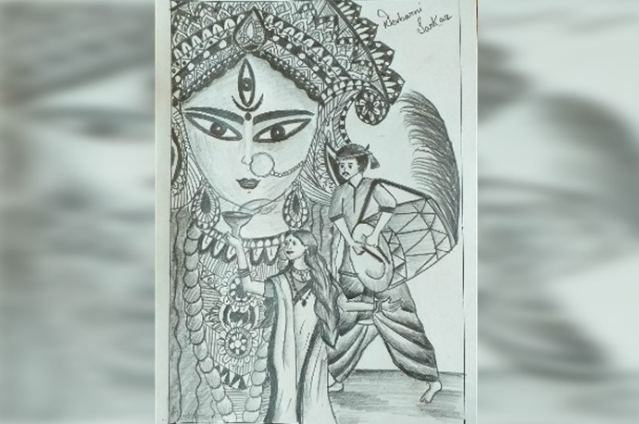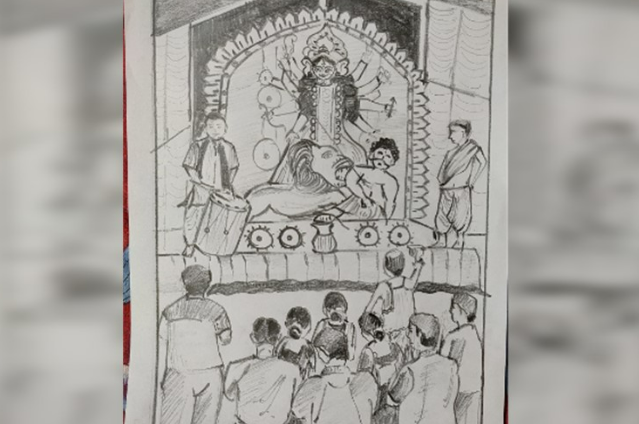
“শিউলি ফুলের গন্ধ মাখা শরৎ আকাশখানী,
কাশফুল আর ঘাসের দোলায় কার ঐ পদধ্বনি?”
"Autumn sky, scented with the scent of flowers,
Whose footsteps in the sway of flowers and grass?"
Different generations, alternate professions, and various persons observe it in their own way; for some, it’s a tradition that’s coming from a long time, for a few, it’s about nostalgia, without a drop of doubt, the young life sips it as the energy drink.
But for human beings, it’s the same, the meeting after a wait of 365 days, shaking hands and touching shoulders with everyone without exception of their caste, religion, and color.
A charming atmosphere with special energy:
If you have seen the extravagant frenzy atmosphere of the Carnaval in Rio De Janeiro, Brazil or Diwali in north India or Christmas in Jamaica; the feeling and the excitement with uncountable happiness of meeting the loved one and making memories is what everyone looks forward to all year.
However, If you ever have been a part of the four days of Durga Puja, then you will figure out how these festive moments grip the heart of everyone in the city as the whole state with open arms and hearts fill themselves with incomprehensible emotions of togetherness. From one point of the city to the other point, uncountable steps of road walks with food and drinks along with friends and family as people dressed up in their new colors.
All the rituals that have been followed throughout the four days of the occasion have been own charm that only those who become a part of it can feel.

The physiognomy of Goddess Durga with her four infants:
When she arrives from Heaven to the universe, just like no mother travels alone without their infants, Goddess Durga to arrives with her two sons and two daughters riding on the Lion.
To her left Saraswati and Karthika while on her right side, one will find Laxmi and Ganesha. The whole structure is named as Chala whereas there will be a picture of Lord Shiva before Goddess Durga.
In her grand avatar, she would be in the appearance of stabbing Mahishasur’s chassis with her trident and all that together as a picture just makes the people of Bengal energized and cherished for new things in life.
The whole structure of the frame where all the Gods and Goddesses stay is being called “Chala”.
Mahalaya: The Ring Bell of the Festival:
Roughly around seven days before the Soshti of Durga Puja, the day is being recalled as Mahalaya. If you ever come in Bengali in the early mornings of the day, you will either hear the sounds of the shows of Mahalaya in Television or from the radio; the latter was almost a supreme thing in the past eras.
Even before the sun when they wake up even in some sleeper eyes, it’s nothing but seems to be like a customary collection of songs and mantras that’s being called as “Mahishasura Mardini’, in the sonorous voice of the greatest ‘Birendra Krishna Bhadra’.
And these mantras that they speak to the speaker is something like: Jago, Tumi Jago (meaning ‘awaken, oh goddess!’).
The beginning of such traditions and facts regarding Durga Puja:
A number of such old traditions and the folklore of the occasion cherish this festival much more in this part of the world in every year.
Chokkhudaan (Offering Eye to Goddess Durga):
It can be called the start when Goddess Durga gets her eyes to look around at her kids. In one of the oldest and quite interesting events which are called Chokkhudaan or the tradition that’s being called the offering of the eyes of Goddess Durga, the beginning occurs.
Generally, it takes around three to four months to create the Chala and when the final stroke of the paint is done, then the eyes are offered. This ritual is supposed to be done in complete darkness and in the presence of the priest and no one is allowed to be present at that moment.
Ashtami Pushpanjali: The shade of the whole festival:
It’s totally a different ‘Cup of Tea’ feeling if you are yet to be part of that morning in Maha-Ashtami. To be brutally fair, that specific day can have its single portion the piece altogether; it feels different to be part of that special occasion.
Generally, or perhaps, you could say in my town I tend to do that so often in the evening of Saptami, that it asks the club or the temple parties the time of when the pushpanjali is going to commence on the next day. There are three times of Pushpanjali done normally in the clubs or in the temple which is divided into three times and for some funny and odd unknown reason, everyone wants to be part of the first part of the Pushpanjali even after knowing that all the three parts are going to the crystal same.
In the morning, people come together and offer flowers to Goddess Durga; the best part of it is how even the strangers who seem to be having no knowledge of the whole fact to get connected with the ritual too. The eighth day of the festival brings a new looked shape to the whole festival and if you ask someone around Bengal, they will perhaps say it’s a sort of a crime to miss the Pushpanjali.

Kumari Puja: Goddess Durga in the body of a young girl:
It’s been the best form of the liturgy during the whole duration of the festival for ten odd days. Goddess Durga is worshipped in many forms during the occasion and one of the renowned versions of it is the one of the Kumari which means Virgin.
A girl with a bright arrangement aged generally under seventeen is being selected. On the day of Ashtami, the Kumari girl is worshipped in front of Goddess Durga which is called the purest form of the whole festival.
One of the most famous Kumari Pujas is the one that Swami Vivekananda began at the Belur Math in Howrah that still continues to be till now with grandeur.
The pandal whooping with locality puja on Ashtami and Nabami:
For those who have a Durga Puja to attend in their house, it sometimes becomes a bit tough to select whether to stay at home during the whole day or even in the evening or whopping around in the streets enjoying the company of the friends with so much fun and food watching various version and style of the Goddess.
There is some sort of easiness in the whole air when everything seems to be in a happy mood with good vibes all around. So many stories, emotions, thoughts, feeling, and good and bad words; all get shredded in two to three to uncounted hearts.
There is no age limit; from someone being a kid to an adult to someone almost at the end of his tenure, all enjoy the period like it will never come again for the second time. Ashtami nights become so special; the different colors of lights all around the streets at different pandals make the whole city the best place to be at.
The Nabami evenings become a double-hearted feeling; there also have been fun and enjoyment but on the back of your mind, you know that on the opposite part of the night, it’s the last day of the year of this Durga Puja. Hevey hearts and a bit of water in your eyes become a part of the life in Bengal on these days in every single year.
Bijoya Dashami and Sindur Khela: The wait for a new year begins:
Dashami becomes such a sad and disappointing time given it’s the end of the Durga Puja. Sindur Khela is a sort of ritual that is being followed in this time frame where the married women gather at the Puja pandals and smear each other with Sindur (Vermillion) much like playing in Holi with the colors. It flags the farewell of the Goddess Durga.
The streets of Kolkata become crowded with thousands of institutes changing themselves in the fashion according to the day and going for their last ride for the year. “আসছে বছর আবার হবে” which means that it will happen again next year, is nothing but a theme tagline that everyone keeps on saying loudly.
End… Yeah, that’s the end. and it’s again the boring time to get back to the school, it’s again that time to start preparing for the exams, It’s again that time to get back to the desks, it’s again time to get back to the office with the clock starts ticking for more 362 days. The charm for the next year is finished. We keep on saying-
“As Goddess Durga returns to her abode, sending you warm wishes on the occasion of Bijoya Dashami. Subho Bijoya!!!”
